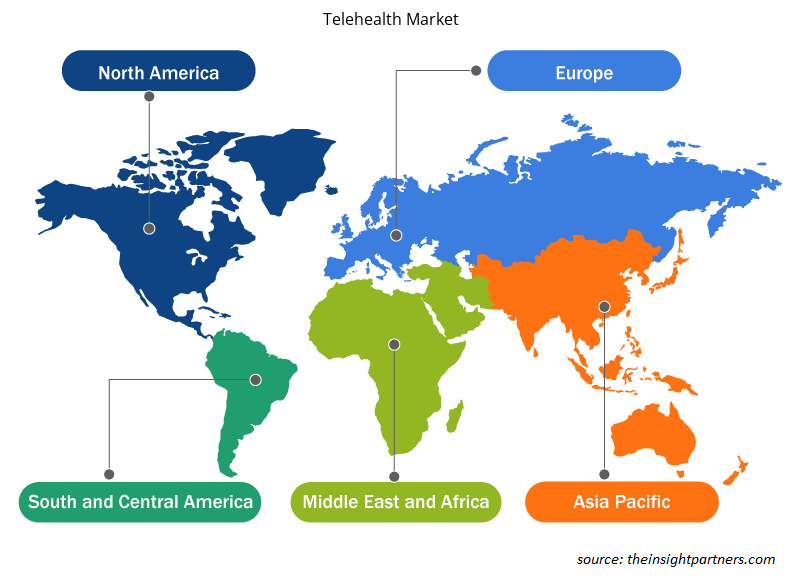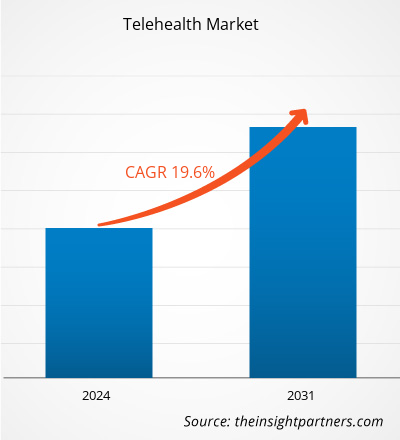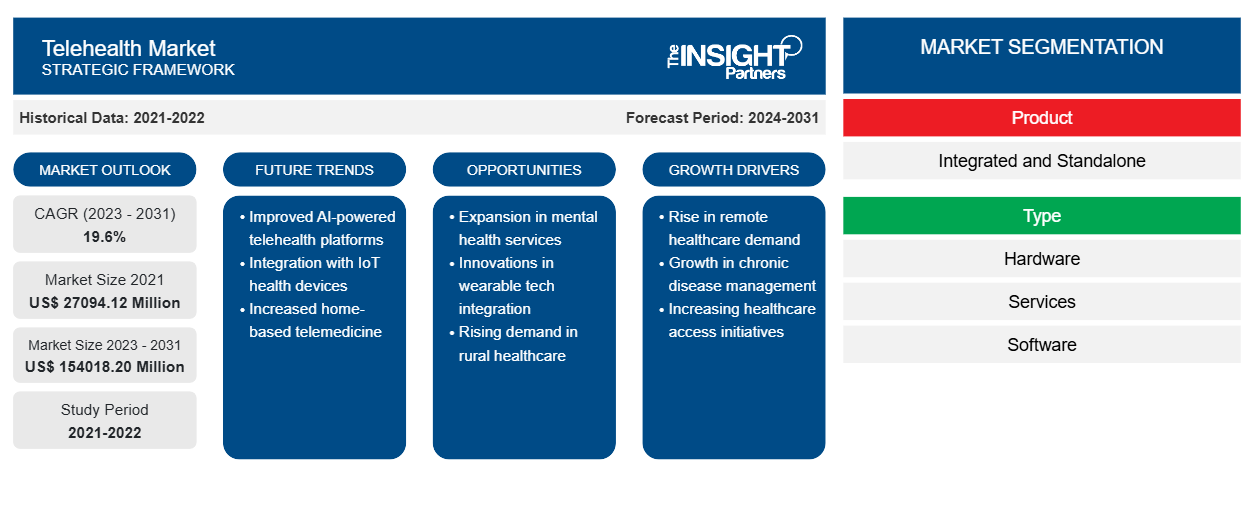远程医疗市场规模预计在 2021 年为 270.9412 亿美元,2023 年为 XX 百万美元,预计到 2031 年将达到 1540.182 亿美元;预计到 2031 年的复合年增长率将达到 19.6%。远程医疗在利用技术改善医疗服务方面发挥着至关重要的作用。随着技术的广泛使用及其在农村地区的采用,远程医疗已显示出显着的优势。此外,它还降低了患者和医疗保健系统的成本,特别是对于居住在农村地区的患者。可以远程诊断患者,并通过存储转发技术或在线会话与临床专家共享他们的数据。心血管疾病患病率的不断上升、治疗的家庭监测以及慢性病治疗成本的降低可能仍然是远程医疗市场的主要趋势。
远程医疗市场分析
远程家庭护理是一种使用最新技术提供护理、监测患者和提供信息的创新方式。监测可以尽早发现疾病并在紧急情况下提供援助。因此,远程家庭服务的使用正在增加。例如,根据 JMIR Publications 发表的一篇文章,2022 年 1 月,儿童及其家人选择了儿科远程家庭护理,因为它比传统医院护理便宜 9%,从而为西班牙更复杂的情况腾出了医院床位。
此外,由于更方便和总体成本更低,人们更喜欢在家中远程上门治疗,而不是去医院接受治疗。例如,根据优质家庭医疗保健伙伴关系发表的一篇文章,2021 年,约 86% 的成年人更喜欢在家中接受“出院后短期医疗保健”,而在美国,只有 5% 的人更喜欢疗养院。远程上门服务为患者和医院提供了节省大量费用的机会。此外,家庭监测计划旨在帮助再次住院或频繁去急诊室的患者在家中舒适地接受治疗。家庭监测计划旨在减少医院就诊次数或再次入院次数以及住院时间。监测计划包括来自护理点的广泛患者健康数据,包括生命体征、体重、心率、血糖、血氧水平、血压和心电图。这些数据可以传输给医院和重症监护病房、专业护理机构、集中式异地病例管理计划和初级保健机构监测中心等机构中的专业医疗专业人员。专业人员远程监控患者并根据健康数据信息提供治疗计划。家庭监控计划旨在通过改善医疗服务、患者治疗效果以及提高医疗保健系统的成本效益来实现医疗保健的“三重目标”。上述因素预计将对远程医疗市场的增长产生积极影响。
远程医疗市场概览
远程医疗市场的增长归因于一些关键驱动因素,例如心血管疾病患病率的上升、治疗的家庭监测以及慢性病治疗成本的降低。然而,缺乏监管和农村地区的医疗服务有限是阻碍市场增长的主要因素。全球远程医疗市场按地区细分为北美、欧洲、亚太地区、中东和非洲以及南美和中美洲。在北美,美国是最大的远程医疗市场。该地区的增长归因于地方政府对远程监控和虚拟护理的大量投资。根据美国疾病控制和预防中心的数据,从 2019 年到 2021 年,美国的远程医疗使用率从 15.4% 增加到 86.5%。此外,数字健康创新有望进一步刺激北美远程医疗市场的增长。
预计亚太地区将成为远程医疗市场增长最快的地区。由于千禧一代远程医疗服务的便利性不断提高以及智能手机用户数量的不断增加,亚太地区的远程医疗市场可能会出现快速增长。预计这些因素将在预测期内促进远程医疗市场的增长。
定制此报告以满足您的需求
您可以免费定制任何报告,包括本报告的部分内容、国家级分析、Excel 数据包,以及为初创企业和大学提供优惠和折扣
-
获取此报告的关键市场趋势。这个免费样品将包括数据分析,从市场趋势到估计和预测。
远程医疗市场驱动因素和机遇
远程医疗在医疗行业的应用案例有利于市场
过去几年,医疗行业的远程医疗发展迅猛。电信使医疗专业人员能够虚拟地评估、诊断和治疗患者。远程监控设备、家庭消息服务、监控中心和语音识别等技术被用于使远程医疗更加精简和高效。随着智能手机的普及和技术先进设备的普及,创新者开始投资充分利用该行业的现状,专注于通过各种移动平台提供优质的医疗保健和舒适感,这将有助于患者跟踪他们的健身计划并通过电话、WhatsApp 或通过多个移动应用程序获得医疗咨询的答案。例如,已经推出了 Teladoc Health、Doctor Anywhere、Doctor On Call 和 ClicknCare 等多个应用程序,帮助患者预约、跟踪他们的咨询和医疗处方,并在整个治疗过程中存储他们的医疗保健信息。远程护理和远程医疗确保医疗专业人员可以为需要护理的患者提供服务,而不会增加疾病传播的风险。
此外,远程医疗已成为医疗保健的支柱,并将在未来很长一段时间内继续发展。最终,远程医疗将成为主要的医疗保健服务模式,结合更好的诊断工具、设备集成和数据互操作性。这种需求可能会在预测期内推动远程医疗市场的发展。
技术发展——远程医疗市场的机遇
各种技术先进的远程医疗产品的推出预计将推动市场增长。例如,2023 年 1 月,全人虚拟护理领域的全球领导者 Teladoc Health 宣布通过一款新的综合数字应用程序推出完全集成的医疗保健体验,为个人提供个性化的全人护理。消费者现在可以从一个地方和一个便携式帐户无缝访问 Teladoc Health 的全方位服务,包括初级保健、心理健康和慢性病管理。预计此类技术进步将为远程医疗市场创造诱人的增长机会。
远程医疗市场报告细分分析
远程医疗市场分析的关键部分是交付类型和交付方式。
- 根据类型,远程医疗市场分为硬件、服务和软件。2023 年,软件部分占据了最大的市场份额。此外,预计同一部分在预测期内的复合年增长率最高。该软件是安全的,可通过手机上的在线服务免费为患者提供远程医疗、健康信息或健康教育。远程医疗软件可在各种环境中执行,从而无需特殊培训并最大限度地减少停机时间。此外,它还有助于流行病学和公共卫生、电子健康记录、个人健康和健身应用、临床参考和患者决策支持。
- 根据交付方式,远程医疗市场分为本地、基于网络和基于云。2023 年,基于网络的交付模式占据了交付模式的最大市场份额。然而,预计在预测期内,基于云的部分将在市场上实现最高的复合年增长率。基于云的交付模式是用于在线计算服务的更安全、更标准化的信息系统,对于提供按需计算资源至关重要。基于云的系统允许用户通过互联网或网络浏览器连接到计算机,从而可以随时随地在任何设备上访问数据。基于云的交付模式系统是一种非常易于管理的替代方案,有助于访问实时信息。
远程医疗市场份额按地区分析
远程医疗市场报告的地理范围主要分为五个地区:北美、亚太地区、欧洲、中东和非洲、南美/南美和中美洲。
就收入而言,北美占据了远程医疗市场份额的主导地位。北美远程医疗市场已细分为美国、加拿大和墨西哥。美国占北美远程医疗市场的最大份额。美国远程医疗市场的增长归因于各种市场参与者,并且已经建立了动态场景。它改变了该地区远程医疗的动态。北美的增长特点是公司通过合作、协作、收购、合并和产品发布来创新远程医疗市场,从而推动预测期内的增长。例如,2021 年 4 月,Inova Health System 提供了一种 FDA 批准的远程医疗选项,用于对接受帕金森病和特发性震颤治疗的深部脑刺激 (DBS) 患者进行远程神经调节。因此,远程监控的日益普及可能会促进美国远程医疗市场规模的增长。
远程医疗市场报告范围
远程医疗市场区域洞察
Insight Partners 的分析师详细解释了预测期内影响远程医疗市场的区域趋势和因素。本节还讨论了北美、欧洲、亚太地区、中东和非洲以及南美和中美洲的远程医疗市场细分和地理位置。

- 获取远程医疗市场的区域特定数据
远程医疗市场报告范围
| 报告属性 | 细节 |
|---|---|
| 2021 年市场规模 | 27094.12 百万美元 |
| 2031 年市场规模 | 154018.20 万美元 |
| 全球复合年增长率(2023 - 2031) | 19.6% |
| 史料 | 2021-2022 |
| 预测期 | 2024-2031 |
| 涵盖的领域 |
按产品
|
| 覆盖地区和国家 |
北美
|
| 市场领导者和主要公司简介 |
|
市场参与者密度:了解其对商业动态的影响
远程医疗市场正在快速增长,这得益于终端用户需求的不断增长,而这些需求又源于消费者偏好的不断变化、技术进步以及对产品优势的认识不断提高等因素。随着需求的增加,企业正在扩大其产品范围,进行创新以满足消费者的需求,并利用新兴趋势,从而进一步推动市场增长。
市场参与者密度是指在特定市场或行业内运营的企业或公司的分布情况。它表明在给定市场空间中,相对于其规模或总市场价值,有多少竞争对手(市场参与者)存在。
在远程医疗市场运营的主要公司有:
- 美敦力
- Cerner 公司
- Tunstall 医疗保健
- AMD 全球医药公司
- 飞利浦医疗
- 思科系统公司
免责声明:上面列出的公司没有按照任何特定顺序排列。

- 获取远程医疗市场顶级关键参与者概览
远程医疗市场新闻和最新发展
远程医疗市场通过收集主要和次要研究后的定性和定量数据进行评估,其中包括重要的公司出版物、协会数据和数据库。以下是远程医疗市场的发展和战略列表:
- 2023 年 11 月,由四名参议员组成的两党小组再次提出一项立法,消除了阿片类药物使用障碍 (OUD) 虚拟处方药物的障碍。(来源:mHealth Intelligence,2023 年)
远程医疗市场报告覆盖范围和交付成果
“远程医疗市场规模和预测(2021-2031)”报告对市场进行了详细分析,涵盖以下领域:
- 范围内所有主要细分市场的全球、区域和国家层面的市场规模和预测
- 市场动态,如驱动因素、限制因素和关键机遇
- 未来的主要趋势
- 详细的 PEST/波特五力分析和 SWOT 分析
- 全球和区域市场分析涵盖关键市场趋势、主要参与者、法规和最新市场发展
- 行业格局和竞争分析,涵盖市场集中度、热点图分析、知名参与者和最新发展
- 详细的公司简介
- 历史分析(2 年)、基准年、预测(7 年)及复合年增长率
- PEST和SWOT分析
- 市场规模、价值/数量 - 全球、区域、国家
- 行业和竞争格局
- Excel 数据集
近期报告
客户评价
购买理由
- 明智的决策
- 了解市场动态
- 竞争分析
- 客户洞察
- 市场预测
- 风险规避
- 战略规划
- 投资论证
- 识别新兴市场
- 优化营销策略
- 提升运营效率
- 顺应监管趋势























 获取免费样品 - 远程医疗市场
获取免费样品 - 远程医疗市场